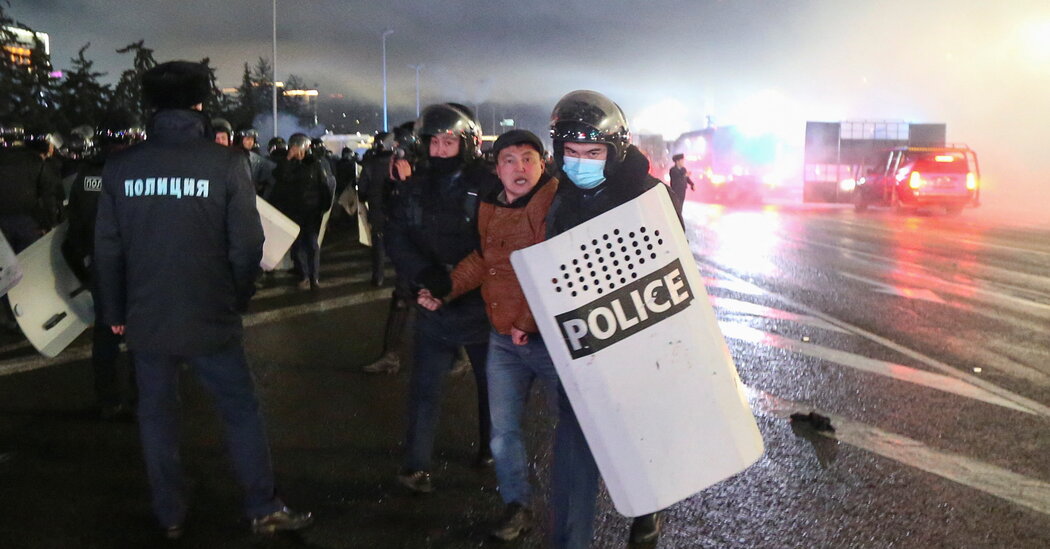
MOSCOW — A Russian-led military alliance said late Wednesday that it would send peacekeeping forces to Kazakhstan at the invitation of the country’s president to help put down a growing protest movement there.
The current chairman of the alliance, the Armenian prime minister, Nikol Pashinyan, said in a statement that the troops would be stationed there only “for a limited time period,” until order could be restored.
He did not elaborate on how many soldiers could be mobilized or how long they might stay. Russia is notorious for sending in troops under the guise of peacekeeping missions that go on to establish a permanent presence in the host countries.
The Kazakh president, Kassym-Jomart Tokayev, issued the invitation earlier in the evening. Calling the demonstrators “a band of international terrorists,” he said he was turning to Russia’s version of NATO, called the Collective Security Treaty Organization, to “help Kazakhstan overcome this terrorist threat.”
The revolt began on Sunday in western Kazakhstan as a protest against a surge in fuel prices. Four days later, with government buildings, TV stations, the airport and numerous businesses stormed by thousands of anti-government protesters, the uprising has expanded into a full-throated attack on an entrenched Kazakh elite widely reviled as autocratic and corrupt.
On Thursday, a police spokeswoman said dozens of people had been killed by the authorities when they tried to storm government buildings, police headquarters and district police offices, the first widespread fatalities involving protesters since the demonstrations started. That announcement came after earlier reports in the local news media that the police had opened fire on demonstrators in the oil city of Atyrau, killing at least one person.
Footage posted online on Wednesday showed thousands of people storming the main government building in the country’s largest city, Almaty.
Smoke billowed from the building that afternoon as the crowd began to disperse. The regional branch of the governing Nur Otan party was also set on fire, local news outlets reported, as was the former presidential residence.
News services reported renewed clashes between protesters and the police, who used stun grenades and tear gas to quell the crowd. Protesters also set fire to the prosecutor’s office in Almaty before heading for the president’s residence.
The Almaty police said that protesters burned 120 cars, including 33 police vehicles, and damaged about 400 businesses, and that more than 200 had been detained. The country’s Internal Affairs Ministry said that eight members of law enforcement had died in the clashes.
The protests began peacefully Sunday in the oil town of Zhanaozen, after the government doubled the cost of liquefied petroleum gas — used to fuel vehicles in Kazakhstan — to about 100 tenge, or 22 cents, per liter. By the time the government announced on Tuesday that it would rescind the price increase, the protests had spread across the country, with broader demands for increased political representation and improved social benefits.
Apparently unsatisfied by an announcement early Wednesday that the entire government would be sacked and that new parliamentary elections were possible, protesters took control of the country’s main airport.
The protests reverberated across the continent to Moscow, where President Vladimir V. Putin was forced to witness another uprising against an authoritarian, Kremlin-aligned nation, following pro-democracy protests in Ukraine in 2014 and in Belarus in 2020.
The protests represent a warning signal for the Kremlin, said Arkady Dubnov, a Central Asia expert in Moscow, describing the government in Kazakhstan as “a reduced replica of the Russian one.”
He added: “There is no doubt that the Kremlin would not want to see an example of such a regime beginning to talk to the opposition and conceding to their demands.”
The timing is particularly awkward for Mr. Putin, who hopes to use three meetings next week with Western delegations to renegotiate post-Cold War international security agreements on Ukraine and what Russia considers its sphere of influence in Eastern Europe and Central Asia.
The revolt also seemed to mark a decisive break with the rule of Kazakhstan’s former president, Nursultan Nazarbayev, who stepped down as president in 2019 but had still kept a hand in the country’s affairs.
Video footage showed protesters toppling a statue of Mr. Nazarbayev in the capital of the Almaty region, Taldykorgan, with people chanted “shal ket,” Kazakh for “Old man, leave!” He has played no role in combating the protests, leaving that to his hand-picked successor, Mr. Tokayev.
While initially conciliatory, the government has taken a steadily harder line against the protesters, imposing a strict state of emergency throughout the country.
Mr. Tokayev said Wednesday that he would assume all formal levers of power and promised to “act with maximum toughness.” Kazakhtelecom, the country’s largest telecommunications company, shut off internet access throughout the country on Wednesday afternoon.
Kazakhstan, with a population of 19 million, is by far the richest country in Central Asia, with a GDP per capita of $27,000 and more than $35 billion in reserves, yet it was still possible for the country to devolve into chaos in a matter of days.
The instability is a potential source of concern among foreign oil companies, particularly in the United States. ExxonMobil and Chevron have invested tens of billions of dollars in western Kazakhstan, the region where the unrest began this month. A Chevron-led consortium is in the midst of a project to expand output at the on-land Tengiz oil field at an estimated cost of $37 billion, one of the single largest energy investments in the world today.
Understand the Protests in Kazakhstan
Many Kazakhs were incensed by the increase in the gas price because their country is not just the recipient of tens of billions in energy investments but also an exporter of oil and gas. The price rise added to the economic misery in a country where the coronavirus pandemic has helped underscore severe income inequality.
Mukhtar Umbetov, a rights activist who took part in protests in Aktau, said that while the turmoil may have been sparked by economic grievances and the pandemic, the root cause was the absence of democratic processes. The Kazakh government, he said, “has removed all legal ways to participate in politics.”
Speaking by phone from Aktau, on the Caspian Sea, he said that “people don’t have any political intermediaries who would solve problems that exist in the country.”
Nevertheless, he said, in a country where the average salary is $570 a month — and where many earn considerably less than that — economic resentments are not to be discounted. “Kazakhstan is rich, but its natural resources are not working in the interests of all; they work in the interests of a small group of people.”
As the protests have unfolded, the demands of the demonstrators have expanded to include broader political liberalization. Among the changes they seek is the direct election of Kazakhstan’s regional leaders, rather than the current system of presidential appointment.
Much of the ire has been directed at the country’s autocratic former ruler, Mr. Nazarbayev, who led the country for 30 years after independence in 1991. Mr. Tokayev became president after elections derided by Western observers as flawed.
After that, Mr. Nazarbayev was formally recognized as the “leader of the nation,” and the country’s capital was renamed Nur-Sultan in his honor. Until now, he had been widely regarded as the shadow leader of Kazakhstan despite the formal transition of power to Mr. Tokayev.
But that appears set to change. On Tuesday, Mr. Tokayev dismissed Samat Abish, Mr. Nazarbayev’s nephew, from the position of first deputy head of the country’s national security service, a successor to the K.G.B. And on Wednesday, Mr. Tokayev replaced Mr. Nazarbayev as head of the country’s Security Council.
Speaking about the unrest, Mr. Tokayev asserted that the protests were “highly organized” as part of a “meticulously thought-out plan of conspirators, who were motivated financially.” He said that people had been “killed and wounded” and that “crowds of bandit elements beat and mocked servicemen, took them naked through the streets, abused women and robbed shops.”
The countries of the former Soviet Union are watching the protests closely. For Russia, the events represent another possible challenge to autocratic power in a neighboring country.
Russia intervened militarily in Ukraine in 2014 after pro-democracy protests erupted there, and the Kremlin offered support to the Belarusian dictator Aleksandr G. Lukashenko as he violently crushed peaceful protests against his autocratic rule in 2020. The Kremlin currently has “peacekeeping” forces stationed in Transnistria and the contested territory of Nagorno-Karabakh, as well as supporting Russian separatists in eastern Ukraine. It also occupies parts of Georgia and Abkhazia.
Andrew E. Kramer contributed reporting from Kyiv, Ukraine.







